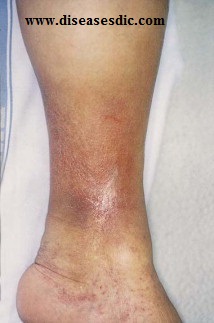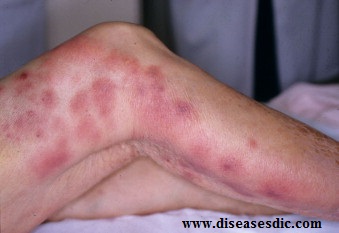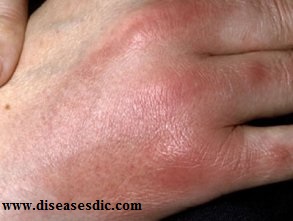Definition
Panniculitis is a broad term referring to inflammation of the fatty layer underneath the skin. It is usually seen in women, on the thighs and lower legs.
There are many types of panniculitis, all with different causes, but the condition generally causes the skin to feel hard and to develop painful red lumps (nodules) or patches (plaques), making it look darker in places.

Panniculitis
Panniculitis usually affects the shins and calves, but may spread to the thighs, forearms and chest. It tends to clear up within six weeks, fading like a bruise, usually without scarring. When the inflammation has settled, a depression in the skin may be left, which can be temporary or permanent. Many people get recurring bouts of panniculitis.
Epidemiology
- The most common panniculitis that is typically seen in young women between the ages of 20 and 40.
- Erythema nodosum is seen 3 to 6 times more frequently in women than men. An underlying cause can be found in approximately two-thirds of cases.1
- In children, it is most commonly associated with streptococcal pharyngitis or perianal infection.
- In adults, it is most commonly associated with drug ingestion, sarcoidosis, or upper respiratory tract infection. Table 59-1 presents the most common associations seen in teenagers and adults.
Types
The types of panniculitis are as follows:
| Septal panniculitis | Affects the connective tissues around the fat |
| Lobular panniculitis | Affects the fat lobules |
| Vasculitis | Inflamed blood vessels |
| Erythema nodosum | Painful red lumps occur on the front of the lower legs accompanied by headaches, fever & eye problems |
| Lipodermatosclerosis | Commonly affects women above the age of 40 years & those who are overweight. It is associated with obesity & problems related to the veins |
| Cold panniculitis | Affects areas of the skin that have been exposed to extreme cold, such as frozen teething rings in children |
| Subcutaneous sarcoidosis | Occurs as an effect of sarcoidosis disease |
| Erythema induratum | Middle aged women are affected around the calf area |
| Weber Christian disease | Causes bumps on various organs, as well as on lower legs and thighs, especially in middle aged women |

Nodular panniculitis
Risk factors
The risk factors for panniculitis include all conditions that can result in a poor immune system, such as:
- Treatment with immunosuppressant medications for recent solid organ transplant
- Administration of chemotherapy for various cancers
- Poorly-controlled diabetes
- Advanced age
It is important to note that having a risk factor does not mean that one will get the condition. A risk factor increases ones chances of getting a condition compared to an individual without the risk factors. Some risk factors are more important than others.
Causes
The following are the possible causes of panniculitis:
Trauma: If injury has been incurred on the skin, specifically the subcutaneous fatty layer of the skin, the development of such conditions is possible, especially when one has an underlying pancreatic problem. Certain traumas are highly causative of panniculitis. These are IV injections, cryosurgery, and rigorous exercise.
Underlying condition: It has been noted that diseases which involve the connective tissue cause panniculitis. Lupus and scleroderma are known causes of the disease. Pancreatitis is also considered one of the underlying conditions that result in panniculitis.
Extreme cold temperature: This is considered a cause whenever there is injury done via contact with extreme cold objects or temperatures. The injury can become or develop painful nodules. Newborns are affected when hypothermia (decreased body temperature) is experienced during childbirth.
Alpha 1 deficiency: This is considered to bring about the skin problem. There are a number of cases where Alpha 1 deficiency has caused panniculitis.
Symptoms
Panniculitis is characterized by tender, red skin bumps (nodules) that originate deep in the layer of fat beneath the skin (subcutaneous). They tend to be large, measuring several centimeters in diameter. The bumps are most common on the legs and arms and occur less often on the buttocks, trunk, and face.
People may have symptoms of general bodywide inflammation such as fever, joint and muscle pain, and feeling ill.
In Weber-Christian disease, bodywide inflammation can also cause organ dysfunction, including problems with the liver, pancreas, and bone marrow, which can be fatal.

You might also have body-wide symptoms, such as:
- Fatigue
- Fever
- General sick feeling (malaise)
- Joint and muscle pain
- Abdominal pain
- Nausea and vomiting
- Weight loss
- Bulging of the eye
Complications
- The complications due to panniculitis are linked to the underlying condition that caused the weak immune system
- One complication is that the nodules may ulcerate and bleed, resulting in the formation of scars on healing
Diagnosis and test
To diagnose panniculitis, your doctor will examine your skin and ask about your medical history and symptoms. Your doctor will likely remove a small piece of your skin, which is called a biopsy. The tissue sample will go to a lab to be checked under a microscope for inflammation and other signs of panniculitis.
Your doctor might also do one or more of these other tests to check for conditions that cause panniculitis:
- A throat swab to check for bacterial infection
- A blood test to check levels of the protein alpha-1 antitrypsin
- Erythrocyte sedimentation rate blood test to look for inflammation in your body
- Chest X-ray
- CT scan
Treatment
Panniculitis often resolves without treatment, but certain methods can speed up recovery. The best treatment is to tackle the underlying cause.
If there is no known cause, doctors may treat panniculitis by reducing the inflammation, and in some cases, surgically removing the bumps or affected areas of skin.
Usual treatments for panniculitis include:
- Treating the underlying causes, such as taking antibiotics for infections
- Anti-inflammatory drugs, such as aspirin, naproxen, or ibuprofen
- Compression stockings, which have been shown to help relieve panniculitis symptoms in the legs
- Bed rest to help the body recover
- Corticosteroids
- Surgery to remove the bumps, though this is generally not necessary
 Diseases Treatments Dictionary This is complete solution to read all diseases treatments Which covers Prevention, Causes, Symptoms, Medical Terms, Drugs, Prescription, Natural Remedies with cures and Treatments. Most of the common diseases were listed in names, split with categories.
Diseases Treatments Dictionary This is complete solution to read all diseases treatments Which covers Prevention, Causes, Symptoms, Medical Terms, Drugs, Prescription, Natural Remedies with cures and Treatments. Most of the common diseases were listed in names, split with categories.








Dr says diff.scabies megallo disase. from leg to face. looks & feels like killing from inside out.few days ago cat rubbed against my leg now its back down looking like will be cut
please consult a doctor for better results.
I experience pain on left lower chest especially when I’m hungry so what kind of disease is that, thanks.
Please consult a doctor to diagnose the problem.